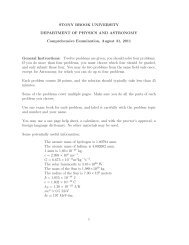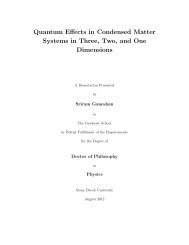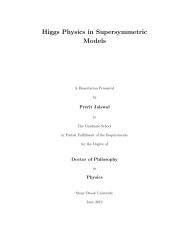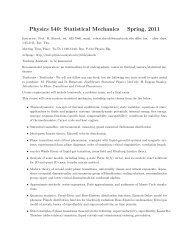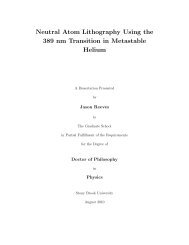Theory of Nuclear Matter for Neutron Stars and ... - Graduate Physics
Theory of Nuclear Matter for Neutron Stars and ... - Graduate Physics
Theory of Nuclear Matter for Neutron Stars and ... - Graduate Physics
Create successful ePaper yourself
Turn your PDF publications into a flip-book with our unique Google optimized e-Paper software.
specific heat) <strong>of</strong> the surface <strong>of</strong> symmetric mater. This description is given below.What appears in the liquid droplet model, however, is the surface free energy per unitarea σ+µ n ν n +µ p ν p , where ν t represent the areal density <strong>of</strong> particles in the surface. It willbe found that these are determined byν t = − ∂σ∂µ t∣ ∣∣T, (6.18)as is expected from thermodynamics. Since our liquid droplet model takes the referenceinterface to be located at the proton surface, this model explicitly considers a skin madeonly <strong>of</strong> neutrons. There are no ‘surface protons’, <strong>and</strong> ν p = 0 . This is consistent withthe statement above that, at a given temperature, the quantity σ is a function <strong>of</strong> a singlequantity, µ n . There<strong>for</strong>e, the surface free energy per area is simply σ(µ n ,T)+µ n ν n . In whatfollows, the neutron chemical potential <strong>for</strong> the surface is denoted by µ s , but it will be shownthat free energy minimization requires µ s = µ no .The surface free energy density <strong>for</strong> spherical nuclei is thusf surf = 4πr 2 Nρ n (σ(µ s ,T)+µ s ν n ) = 3ur N(σ(µ s ,T)+µ s ν n ). (6.19)Once again, following the discussion <strong>of</strong> Lattimer & Swesty [22], the consequences <strong>of</strong>nuclear de<strong>for</strong>mation or shape change are taken into account by the surface shape factor s(u),so thatf surf = 3s(u)r N(σ(µ s ,T)+µ s ν n ). (6.20)Obviously, s(u) = u <strong>for</strong> a sphere. As is the case <strong>for</strong> c(u), the precise <strong>for</strong>m <strong>for</strong> s(u) will berequired.In practice, the results <strong>of</strong> plane-parallel surface energy calculations are most easily renderedin terms <strong>of</strong> the functions σ(x,T) <strong>and</strong> µ s (x,T), where x is the reference asymptoticproton fraction <strong>of</strong> the dense phase. Note that x is equivalent to x i <strong>for</strong> a plane-parallelsurface, but is not necessarily equivalent to x i <strong>for</strong> a finite liquid droplet nucleus. The quantityx is simply a convenient intermediate variable used to simplify the construction <strong>of</strong> σ(µ s ).As in section 3.4, we write the surface tension as a two-parameter function times atemperature dependence:( )2·2 α +qσ(x,T) = σ o h(x,T). (6.21)x −α +q +(1−x) −αThe quantity σ o is the zero-temperature, symmetric matter, surface tension. In case <strong>of</strong>Skyrme <strong>for</strong>ce model, the numerical calculation <strong>of</strong> surface tension is not stable since it is adifferential equation rather than an integral equation. The numerical method is describedin Ravenhall et al. [29].92





